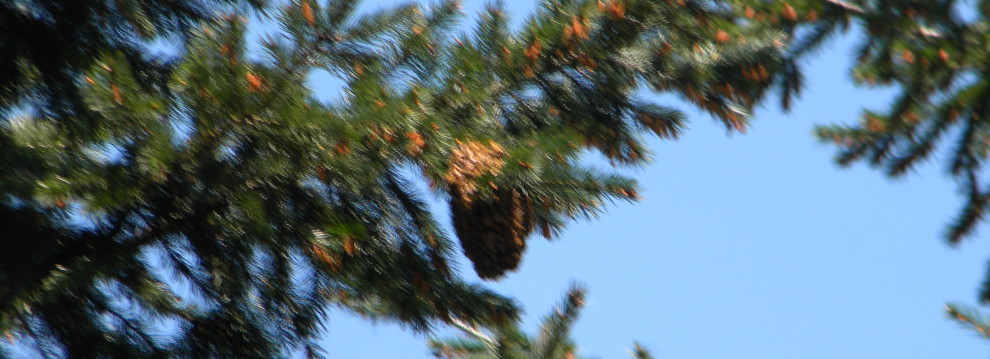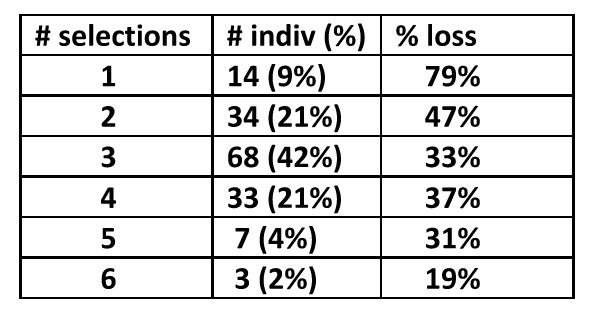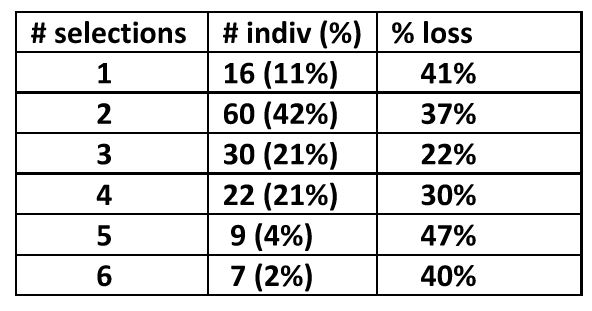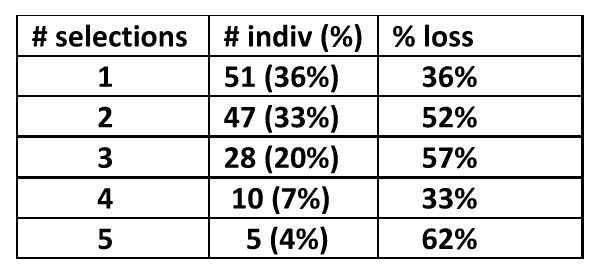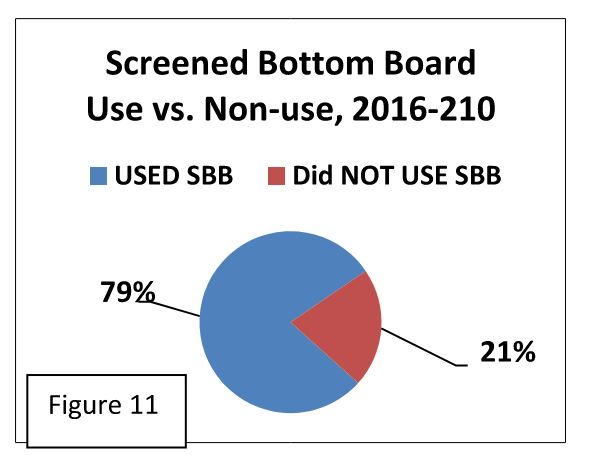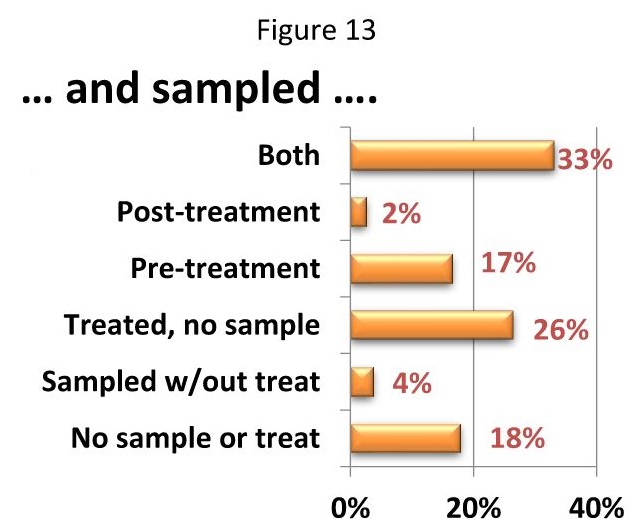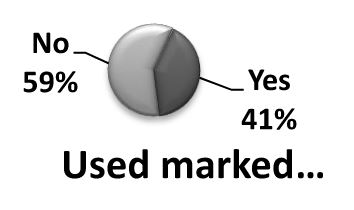** Looking for a report in your specific region? Refer to the Individual Club Reports page.
** Scroll down to see the Washington Backyard Beekeepers Winter Bee Loss Report, 2020-21 or click here to view Washington as PDF.
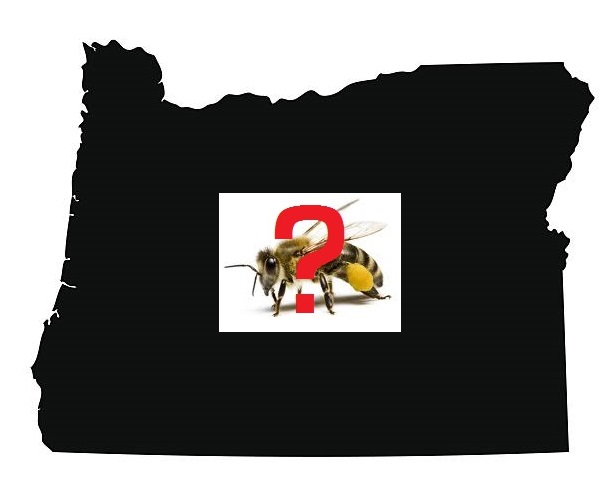
Winter Bee Losses of Oregon Backyard Beekeepers for 2020-2021
by Dewey M. Caron
Click here to view a PDF of Oregon report.
Overwintering losses of small-scale Oregon backyard beekeepers decreased to 35% this winter after the disastrous level of 48% colony losses two years ago and 38% last winter. This report presents the results of our 12th season of Oregon hobbyist/backyard beekeeper surveys. This annual survey is conducted at www.pnwhoneybeesurvey.com. Herein we discuss the data provided by 328 Oregon beekeepers, which is 26 more respondents than last year. Results of the 163 Washington respondents completing surveys (30 more than last year) are included in a separate loss report.
2020/2021 State/Club Losses
Club results of 12 local Oregon associations and 6 Washington associations (+ “other” category) are shown in Figure 1. Colony numbers ranged from 1 to 40 colonies in Oregon (Average 4.77 colonies, medium number = 3 colonies) and 1 to 39 in Washington (Average 5.16 colonies, Median number = 3). The number of respondent individuals is listed next to the association name. The bar length is the average club loss percentage for the year.
Figure 1

Overwinter losses of members of different organizations varied from a low of 27% for the Tualatin Valley beekeeper respondents to a high of 55% for Columbia Association. The 2X range of losses, was less than last year (4X difference) or the year before (3X difference). The difference between the two states – 2 percentage point higher loss rate in Washington – is the closest it has been in several survey years (last year Oregon loss rate was 38% and Washington loss rate was 50%). The 11 “OR-other” includes beekeepers In Coos Co, South coastal range, Douglas Co, + 6 in Klamath Falls area. The 24 “WA-other” includes beekeepers mostly west of the Cascade Range. The Puget sound east are beekeepers mostly in the Seattle area. Three quarters of our Pacific Northwest Honeybee Survey respondents keep bees along the I-5 corridor between Eugene and Seattle.
2020-2021 Overwinter Losses by Hive Type
The loss statistic was developed by asking number of fall colonies and surviving number in the spring by hive type. Respondents had 1,564 fall colonies (211 more than last year) of which 1012 colonies survived to spring equating to a 35% loss (or 65% survival), an improvement of 3% points over the previous winter (38%) loss rate. Eighty-seven percent of hives were 8-frame and 10-frame Langstroth hives which had a survival rate of 65%. There were 74 fall nucs (68% survival rate). Among non-traditional hive types were 45 top bar hives (44% survived) and19 Warré hives (51% survived). Among other hive types, 48 were horizontal hives (moveable comb) and up to 16 (not all other hive types were Identified) that included tree stump and other non-traditional hive types. Thus, at most, 80 (5%) of hives were non-traditional Langstroth hives.
Figure 2

The 30% winter losses of PNW 8-frame Langstroth hives was slightly less compared to the 37% loss rate of 10-frame Langstroth hives. The loss rates of Langstroth 8 and 10 frame hives over the past 7 years has averaged 37% for 8 frame Langstroth hives and 40% loss for 10 frame hives respectively. Nuc losses are typically higher than losses of 8 or 10 frame Langstroth hives but this year came in at 32% loss. The Nuc 6-year average loss is of 50%. This year’s Top Bar hive loss (56%) is only 2 % points over the 6-year average loss of 54%. The 2021 Warré hive loss rate of 47% is a higher loss than the 6-year average of 40%. Although many beekeepers come and go, it is interesting that each survey year Top Bar and Warré hives numbers remain steady at slightly over 5% of total hives.
2020-2021 Loses Based on Hive Origination
We also asked survey respondents to characterize their loss by hive origination. The result is graphically presented below in Figure 3. Overwintered colonies obviously had the best survival (28%) with the 29 feral transfers also excellent. Splits, swarms and nucs were higher with package bee survivals exhibiting double the losses of the overwintered colonies.
Figure 3

2020/2021 Individual Hive Losses
Thirty percent 98 individuals) of Oregon respondents had NO LOSS overwinter, whereas 21% (69 individuals) lost 100% of fall colonies. Figure 4 below shows loss of 1, 2, 3, 4 and 5 colonies; the loss of 1 single colony (by 132 individuals) represents 57% of total individuals reporting loss. Nineteen individuals lost 6 or more colonies. Highest loss by a single beekeeper was 17 colonies. Loss numbers are reflective of the fact that backyarders keep on average 3 colonies. Those individuals losing 1, 2 or 3 colonies lost 53% of total colony loss statewide this past winter.
Figure 4

Graph 5 looks at losses of individuals who had 10 to 40 colonies. This group lost 175 total colonies which is 28% of total losses. Thus individuals with 10 to 40 colonies (Averge colony number=15) lost 4.7 colonies per individual and a smaller percentage of colonies (28%) than the overall group (35%). Indivdiuals with 1 to 9 colonies lost 1.6 colonies on average.
Figure 5

Overwinter Losses the Past 12 Seasons
The losses of the past 12 years are graphed below in Figure 6. Despite the lower losses the past 2 seasons the average loss by Oregon beekeepers is 40%. This average loss has changed little in the past 12 years although season with heavier loses have occurred. Comparing the annual losses of backyarders with commercials is shown in Figure 7. The commercial losses are obtained from a different paper survey distributed by Oregon State University. Four Oregon commercial and six semi-commercial beekeepers (26,175 colonies, approximately 30% of the estimated total number of colonies in the state) reported overwinter losses of 24%. Interestingly this year losses of the six semi-commercial (sideliner) beekeepers (average colony number 164) were 21% and losses of the commercial beekeepers (average colony number 6298) were slightly higher, 24%. The normal progression is commercial loses lowest followed by sideliner then small-scale beekeepers with 10+ colonies (this year 28% figure 5) and finally the backyard beekeepers with heaviest losses. Small scale (backyard) beekeeper losses have ranged from six to 20 percentage points greater compared to losses of commercial/semi-commercial beekeepers over the last 12 years as shown in Figure 7. Twelve-year average Backyard=40% loss and 12-year commercial/semi-commercial loss = 21%. The dashed lines are loss trend.
Figure 6

Figure 7

Who are Survey Respondents?
To better characterize the survey population, we tallied individual number of fall colonies for the 328 respondents. As indicated in the blue bar of Figure 8. Fifty-six individuals had 1 colony, 75 had 2 colonies (the most common colony number), 62 individuals had 3 colonies (the middle number), etc. 37 individuals (11% of individuals) had 10+ colonies. Highest colony number was 40.
We also asked how many years of beekeeping experience survey respondents had as indicated by the red bars of Figure 8. Thirty-nine had 1 year, 33 had 2 years, 38 had three years which was just over 1/3rd of total respondents. The greatest number was 5 years (44 years’ experience, which was also the middle number years of beekeeping experience). On other end of spectrum, 63 individuals (19%) had 10+ years’ experience. 62 years’ experience was the highest.
Figure 8

Nearly three quarters of Oregon beekeeper respondents (71%) indicated they had a mentor available for the first years of beekeeping. This is about same as in previous years. This is encouraging as the learning curve is a steep one for new beekeepers and mentors can significantly help new individuals get through the critical early years of keeping bees.
Perceived Colony Death Reason and Acceptable Level
We asked individuals that had colony loss (98 individuals had no loss) to estimate what the reason might have been for their loss (multiple responses were permitted). There were 445 total listings, 1.86/individual. Varroa (111 selected -46% of respondent choices), followed by Weak in the fall (82 chose 34%), Queen Failure (69 selected 29%), starvation and poor wintering (both 31 choices 13%) were most commonly checked. 40 individuals chose Don’t know (17%). Among other, 17 individuals listed yellow jackets, 12 fire/smoke, 11 pesticides, 9 moisture and 7 CCD. Other reasons written in under other included beekeeping error, small hive beetle, ants, mice, swarming, absconding and late colony hiving.
| Varroa mites | Queen failure | Weak in fall | Star-vation | Yellow jackets | Pest-icides | Don’t know | Other | |
| Loss (#) reason (%) | 111 (46%) | 69 (29%) | 82 (34%) | 31 (13%) | 17 (7%) | 11 (5%) | 40 (17%) | 48 (14%) |
Acceptable loss: Survey respondents were asked reason for loss. Fifty (16%) indicated zero (no loss). Forty one percent of individuals indicated 15% or less. 20% was medium choice. Thirteen percent said 50% of greater was an acceptable loss level. See table below.
| DK | Zero | 5%loss | 10%loss | 15%loss | 20%loss | 25%loss | 33%loss | 50%loss | 75%loss | 100%loss |
| 8 | 50 | 20 | 39 | 21 | 59 | 48 | 36 | 39 | 1 | 1 |
Why colonies die?
There is no easy way to verify reason(s) for colony loss. Colonies in the same apiary may die for different reasons. Examination of dead colonies is at best confusing and, although some options may be ruled out, we are often left with two or more possible reasons for losses. A dead colony necropsy can be of use. Opinions vary as to what might be an acceptable loss level. We are dealing with living animals which are constantly exposed to many different challenges, both in the natural environment and the beekeeper’s apiary. Individual choices varied from zero to 100%, with medium of 20%.
Major factors in colony loss are thought to be mites and their enhancement of viruses especially DWV (deformed wing virus), VDV (Varroa destructor Virus (also termed DWV B) and chronic paralysis virus. Declining nutritional adequacy/forage and diseases, especially at certain apiary sites, are additional factors resulting in poor bee health. Yellow jacket predation is a constant danger to weaker fall colonies. Management, especially learning proper bee care in the first years of beekeeping, remains a factor in losses. What effects our changing environment such as global warming, contrails, electromagnetic forces, including human disruption of them, human alteration to the bee’s natural environment and other factors play in colony losses are not at all clear.
There is no simple answer to explain the levels of current losses nor is it possible to demonstrate that they are necessarily excessive for all the issues our honey bees face in our and their environment. More attention to colony strength and possibility of mitigating winter starvation will help reduce some of the losses. Effectively controlling varroa mites will help reduce losses.
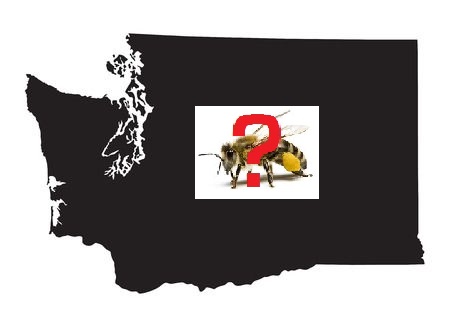
Winter Bee Losses of Washington Backyard Beekeepers for 2020-2021
by Dewey M. Caron
Click here to view a PDF of Washington report.
Overwintering losses of small-scale Washington backyard beekeepers decreased this past winter, dipping 14 percentage point below the 6-year loss average. One hundred sixty-three (163) Washington respondents completed survey, 30 more than last year. Information on winter losses and several managements related to bee health was included on the electronic honey bee survey instrument www.pnwhoneybeesurvey.com.
Response by local Oregon (OR) & Washington (WA) association varied as indicated by blue bars in Figure 1. Statewide loss level is highlighted with orange bar. The number of respondent individuals is listed next to the association name. The bar length is the average club loss percentage for the year. Survey included 845 fall Washington beekeeper colonies. Total WA backyard beekeeper overwinter loss = 37% loss, 13 percentage points less than last year.
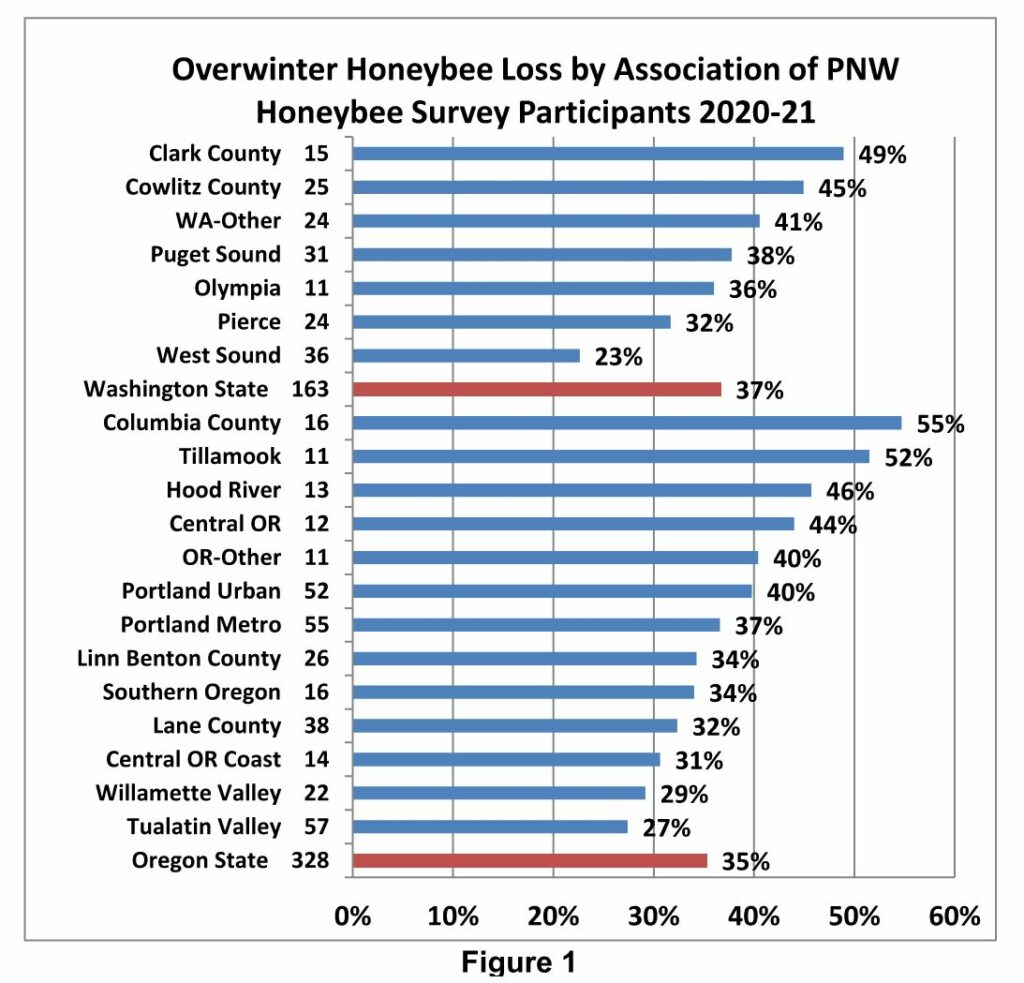
2019-2020 Overwinter Losses by Hive Type
The Washington survey overwintering loss statistic was developed by subtracting number of spring surviving colonies from fall colony number supplied by respondents by hive type. Results, shown in Figure 2 bar graph, illustrate overwintering losses of 163 total WA beekeeper respondents (845 fall colonies). Langstroth 8 and 10 frame beehives (87% of total) had lower average losses (37.5%) than the 29 Top Bar and Warré hives (52%). In the category other, 18 were horizontal Langstroth hives; 3 were non movable comb types; non Langstroth (movable comb) hives = 4%.
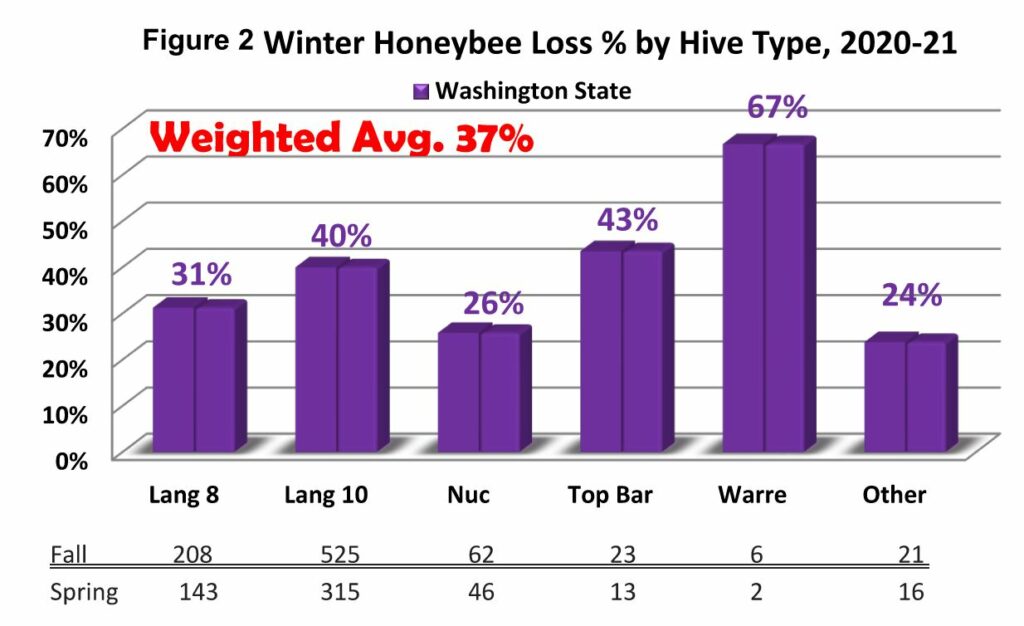
The WA respondents to the electronic survey managed up to 40 fall colonies. Twenty-six individuals had 1 colony (and had heaviest colony loss of 62%), 37 respondents had 2 colonies (the greatest number) and 21 individuals had 3 colonies (84 individuals). Three was median number (as was Oregon).Typical of survey, eighty-four-eight individuals (52% of respondents) had 1, 2 or 3 fall colonies (loss level of 51.5%). Forty-four individuals had 4 to 6 fall colonies and had loss level of 48%. Twelve individuals had 7-9 colonies, they had loss level of 36%, fourteen individuals had 10-16 colonies with loss level of 32% and the 7 individuals with 20-39 colonies had loss level of 16%. Twenty-one individuals (13%) had 10 or more colonies. They lost 24% of their colonies compared to 37% overall loss for Washington beekeepers. See Figure 3 (graphs to left).
Seventy-nine individuals (49% of total) had 1, 2 or 3 years of experience; they had a 39% loss level – first year individuals had 38% loss. Thirty-three individuals (24% of total respondents) had 4 – 6 years’ experience (medium number = 4) with a 23% loss, 13 individuals had 7-9 years experience (loss level 37%), 16 had 10-15 years keeping bees and 38% loss level and 12 had 20 to 35 years experience (highest level) and they had a 47% loss level. Clearly this is opposite of the individuals with colony numbers. Figure 3. Arrows are colony loss; blue bars represent percent individuals. See Figure 3 (graphs to right)
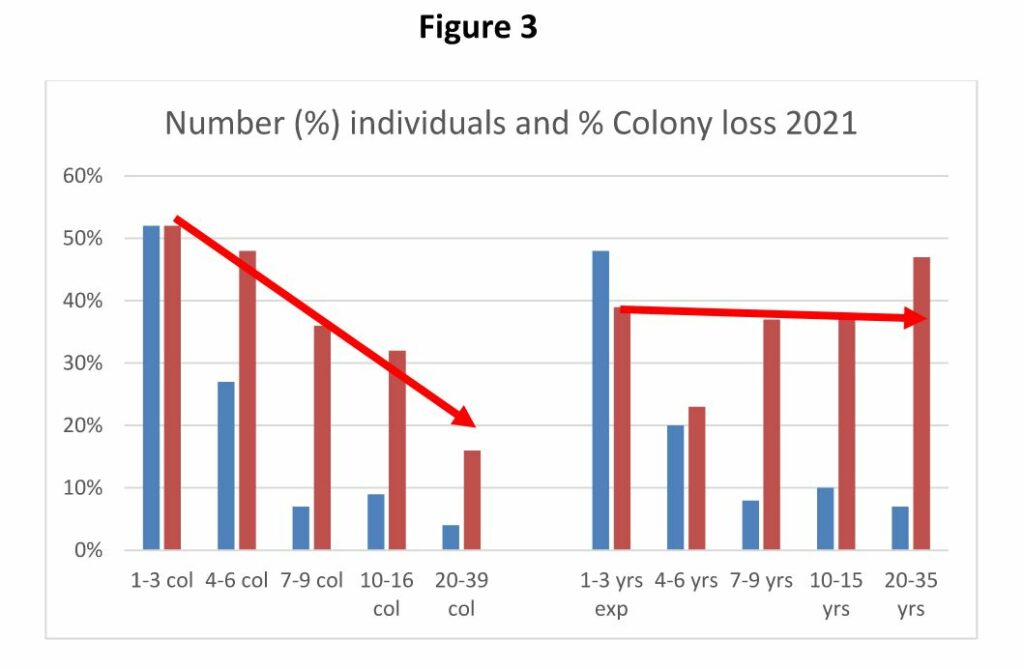
One hundred ten (67.5%) WA beekeepers had an experienced beekeeper mentor available as they were learning beekeeping. This percentage was down from 76% and 73% the two previous years.
Survival Based on Hive Origination
We also asked about hive loss by origination. Data shown in Figure 4. Best survival was previously overwintered colonies. All but nucs had similar loss level. The Oregon beekeepers had the same situation with losses overwinter from nuc origination being higher than the remaining originations (see OR statewide report). Figure 4 below.
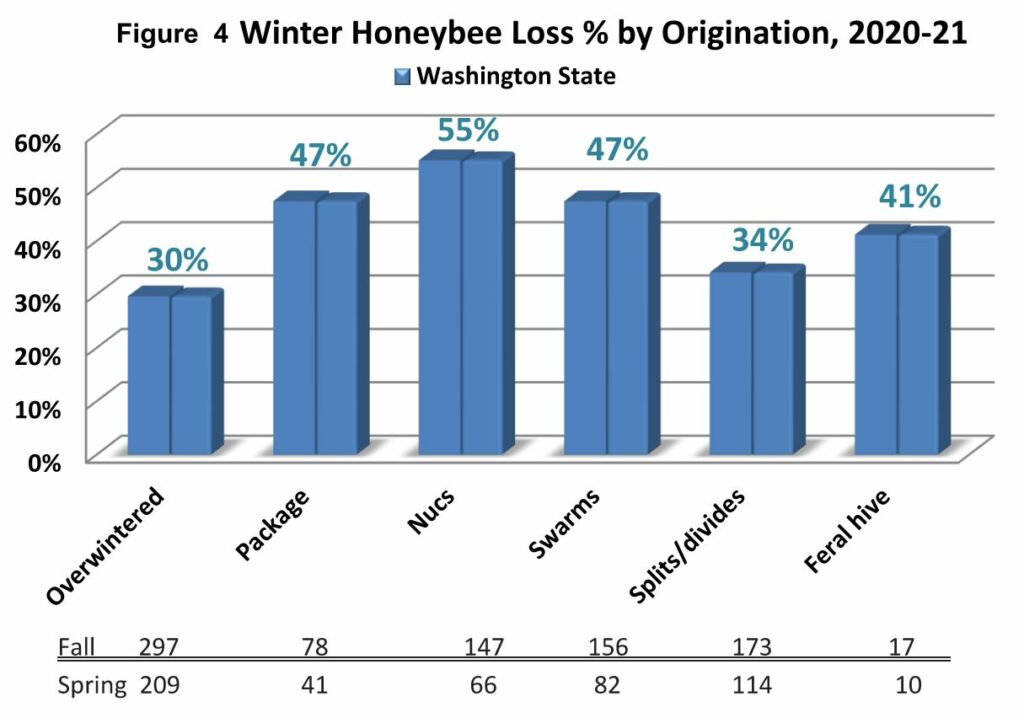
Among 163 WA beekeepers, 37 individuals (14%) maintained more than one hive type. For the total WA beekeeper respondents, 43 (26%) had no loss and 46 individuals (28%) had total loss. Fifty-two WA individuals lost 1 colony, 24 individuals lost 2 colonies and 16 individuals lost 3 colonies (77% of individuals with losses). Four individuals lost 10 or more colonies; highest loss was 12 colonies. Data in Figure 5.
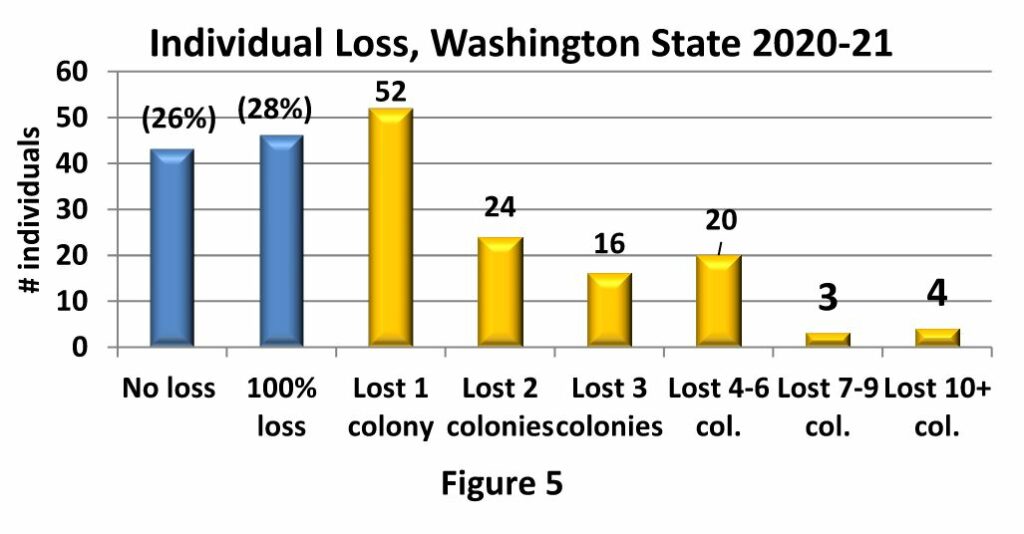
Comparison to Larger-Scale Beekeeper Losses
A different (paper) survey instrument was mailed to Pacific Northwest (PNW) semi-commercial (50-500 colonies) and commercial beekeepers (500+) asking about their overwintering losses. Comparison is shown in Figure 6 below with approximate number of colonies represented by the commercial/semi-commercial beekeepers and number of individual backyarder survey respondents. Also shown is the trend line of losses of both groups. Average loss level for Washington backyarders=49.6% and for Washington commercial/semi-commercial beekeepers = 33.3%.
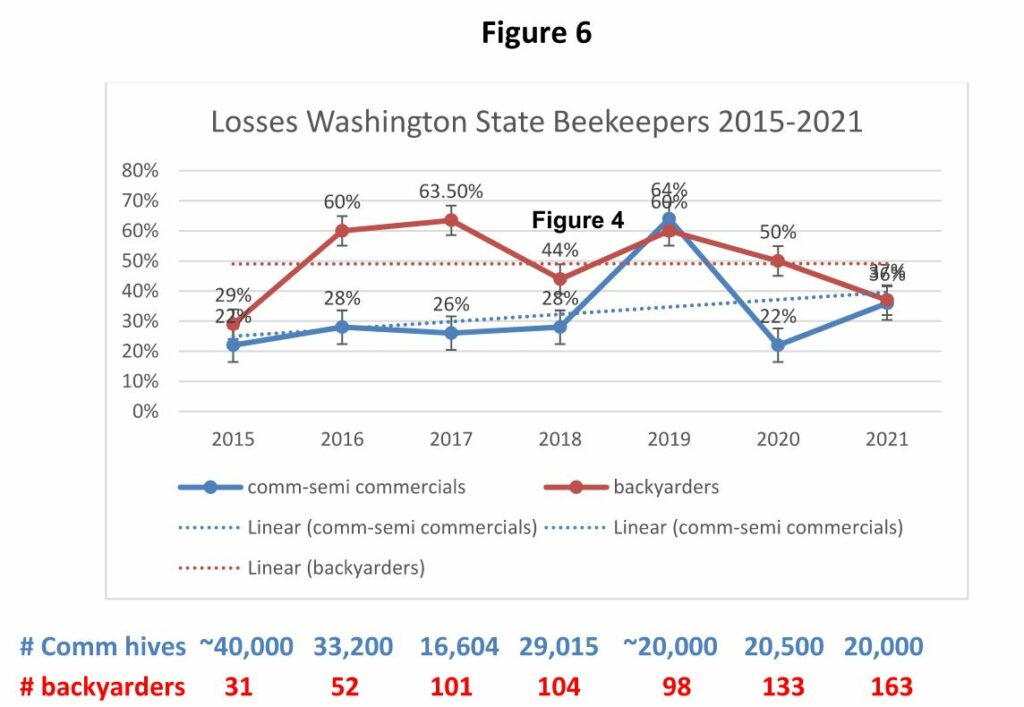
Backyard losses have consistently been higher, in some years double the losses of larger-scale beekeepers but in 2018-19 the commercial losses were higher than backyarder losses. Number of colonies of the commercial keepers returning surveys were essentially the same this past season (returns were an estimated 26% of the NASS estimate of 77,000 colonies in the state). The reasons backyarders have had higher losses 6 of the past 7 years are complex. Commercial and semi-commercial beekeepers examine colonies more frequently and they examine them first thing in the spring as they take virtually all of their colonies to pollinate almonds in February. They also are more likely to take losses in the fall and are more pro-active in varroa mite control management.
The PNW survey was conducted in part to “ground truth” the annual BeeInformed Survey (BIP) also conducted during April. The BIP survey includes a mailed survey to larger-scale beekeepers and an electronic survey to which any Washington beekeeper can submit their data. Losses reported include colonies of migratory beekeepers who reported WA as one of their yearly locations. The BIP survey for the 2015-21 annual surveys reports receiving responses from 90 to 95% of respondents exclusive to Washington but loss is computed on no more than 4% of the colonies exclusive to Washington state, indicating the BIP tally is primarily of commercial beekeepers (who almost exclusively move to CA for pollination of almonds). Average 7-year BIP WA loss is 26.7%. To access this data, see https://research.beeinformed.org/loss-map/
Seven year loss history
The 7-year record of losses is shown below with the trend line for Washington backyarders. Average loss is high at 49.6%.
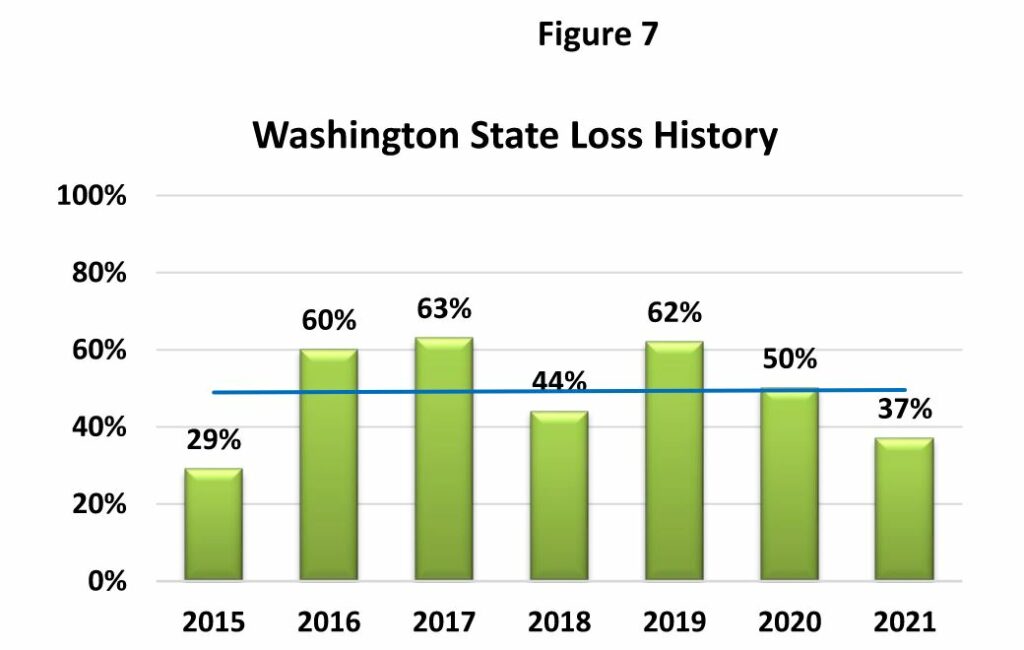
Apiary sites and moves
Twenty survey respondents had bees at more than a single apiary. Half that number, 10, moved bees. Four moved close to get better yard site, for neighbor issue, three moved close for honey and due to loss of apiary and four moved further distance for honey and personal move.
Colony death perceived reason and acceptable loss level
We asked survey takers who had winter losses for the “reason” for their losses. More than one selection could be chosen. In all there were 232 WA selections (2.4/individual) provided. Weak in the fall (38 individual choices), Varroa mites (50) and queen failure (31 selections) were most common choices. Figure 7 shows the number and percent of factor selections.
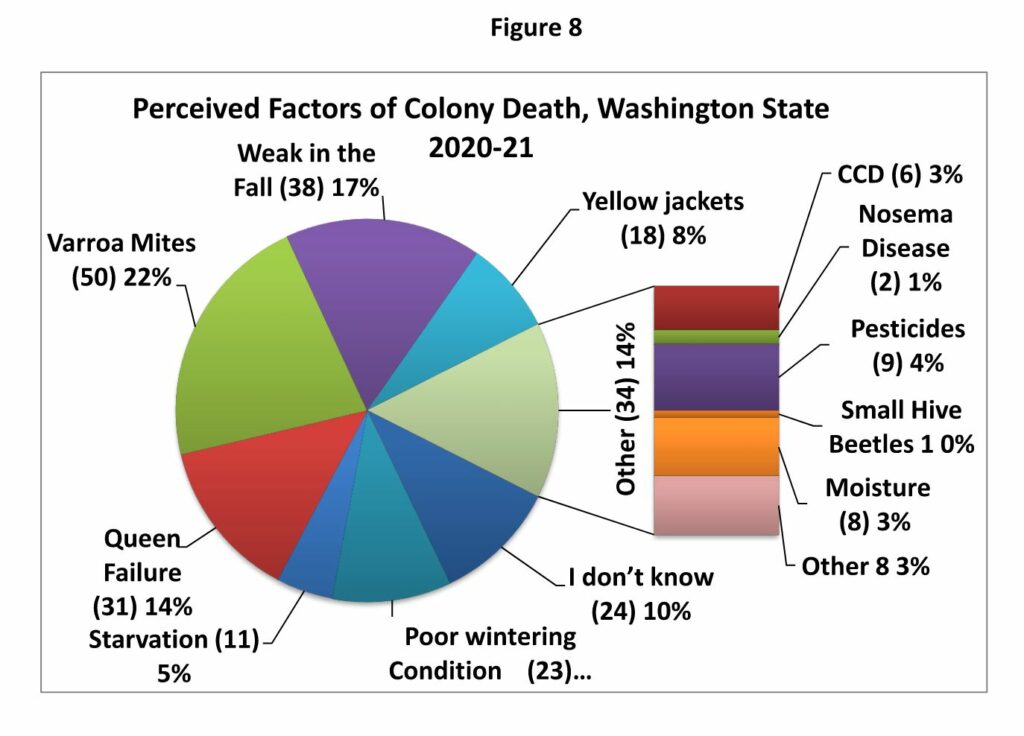
Acceptable loss: Survey respondents were asked reason for loss. Nineteen (12%) indicated zero (no loss). Sixty-seven percent of individuals indicated 15% or less. 15% was medium choice. Twenty-two percent said 50% of greater was an acceptable loss level. See table below.

Why do colonies die? There is no easy way to verify reason(s) for colony loss. Colonies in the same apiary may die for different reasons. There appears to be no single reason for loss and a good deal of variance in opinion as to what might be an acceptable loss level. We are dealing with living animals which are constantly exposed to many different challenges, both in the natural environment and the beekeeper’s apiary. Major factors are thought to be mites, pesticides, declining nutrition adequacy of the environment and diseases, especially viruses and Nosema. Management, failure to do something or doing things incorrectly, remains a factor in our losses. More attention to colony strength and checking stores to help avoid winter starvation will help reduce some of the losses. So, there is no simple answer to explain the levels of current losses nor is it possible to demonstrate that they are excessive for all the issues facing honey bees in the current environment.
Colony Managements
We asked in the survey for information about some managements practiced by respondents. The survey inquired about feeding practices, wintering preparations, sanitation measures utilized, screen bottom board usage, mite monitoring, both non-chemical and chemical mite control techniques and queens. Respondents could select multiple options and there was always a none and other selection possible. This analysis seeks to compare responses of this past season to previous survey years.
Most Washington beekeepers do not perform just one management to their colony (ies) toward improving colony health and overwintering success. This analysis however compares a single factor equated with loss level. Such analysis is correlative and doing a similar management as fellow beekeepers does not necessarily mean you too will improve success.
FEEDING: Washington survey respondents checked 475 feeding options = 3/individual. Four individuals made no selections – they had 29% loss. Fourteen selected a single choice and had 79% loss level (10 made selection of sugar syrup – they had 75% loss), 34 indicated 2 choices and had a 47% loss (12 individuals selecting frame honey + 2nd choice had 58% loss whereas those 20 selecting pollen patties and sugar in some form, mainly sugar syrup had 27% loss). Table illustrates the relationship of number of selections to percent making selection (median was 3) and percent loss of those individuals. Clearly the greater the selections, the better the survival (lower loss rate).
The choices, with number of individuals making that selection is in ( ), bar length indicates loss level of individuals doing this management is shown in Figure 9. Those bar lengths to left of 37% (green dashed line) had better survival while those to right had greater loss level.
For individuals indicating one or more feeding managements (4 said none – they had 29% loss compared to the 3 selecting none last year had a 50% loss), feeding sugar syrup was the most common feeding option of respondents (143 individuals, 90% of respondents, last year it was 76%). Their loss rate was 35%, statistically same as overall average. One hundred seven individuals fed pollen patties (66%, last year 61%) and had 5 percentage point better survival. The managements that showed best survival included feeding frames of pollen (23% loss) and feeding non-liquid sugar, except for fondant)
For the last 4 years of survey losses individuals doing no feeding had poorer survival all 3 of 4 years (this year was the exception). Individuals that fed sugar syrup had marginal lower loss level in 3 of four years (including this year) as did those using frames of honey to feed bees; however, this year the 56 feeding frames of honey had 9 percentage points poorer survival. Individuals feeding non–liquid sugar in the form of hard candy likewise had lower losses in 3 of 4 years; this year a 12 percentage point better survival. For individuals feeding protein, protein patty users showed slightly better survival in 3 of 4 years; dry pollen feeders had significantly better survival in three of the four years; this year they had average losses.
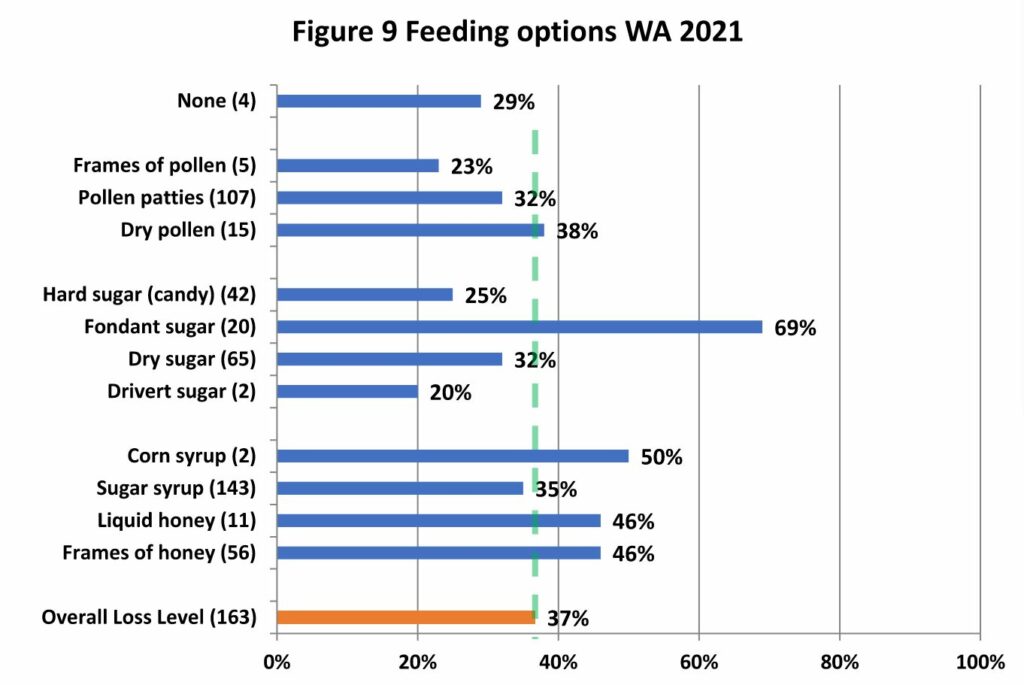
WINTERING PRACTICES: We received 401 responses (2.8/individual compared with 2.5/individual last year) indicating WA beekeeper wintering management practices (more than one option could be chosen). Nineteen individuals (12% compared to 8% last year) indicated none of the several listed wintering practices was done; these individuals had a 48% loss an eleven percentage point elevation form normal 37% winter loss, compared to 74% winter loss last year which was 24 percentage points higher loss than overall loss of 50%.
For those indicating some managements, 16 did one single thing and had 41% loss level, 60 respondents doing 2 (median) had 37% loss, 30 had 3 choices with a 22% loss (the lowest loss level), 22 did 4 (30% loss), 9 made 5 choices but had 47% loss and the 7 indicating 6 choices had loss level of 40%. Three or four choices had best survival percentage most common wintering management selected was ventilation/use of a quilt box at colony top (72 individuals (51% loss), followed by rain shelter provision (60 individuals 48% loss) and upper entrance bee access (58 individuals, 38% loss). Figure 8 shows number of individual choices and percent of each selection. Bar length below 50% (blue dashed line) had better than average winter survival.
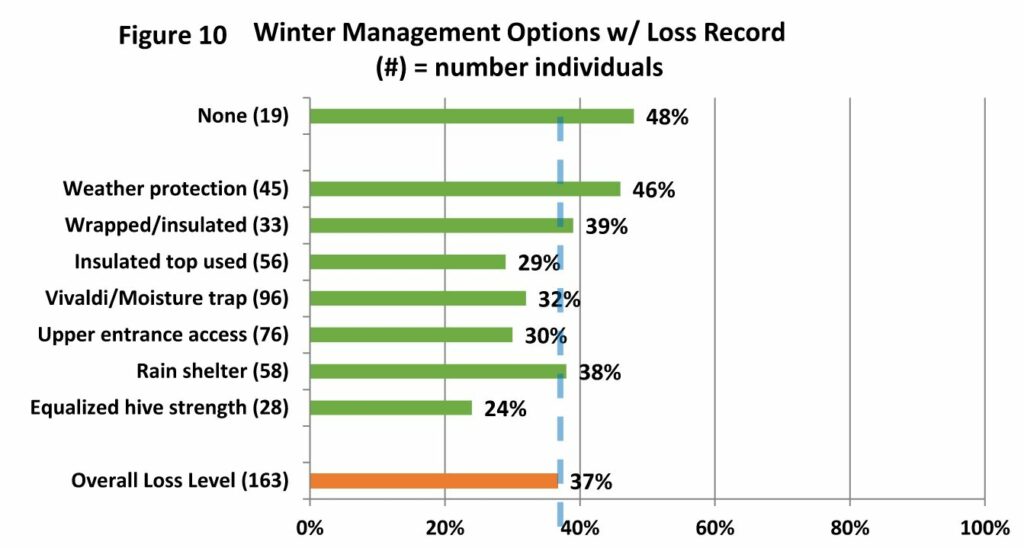
Over the past four years a couple of winterizing management improved survival. Those doing no winterizing had higher losses all 4 years; this year 11 percentage points lower. Equalizing hive strength in the fall demonstrated lower loss levels in all four recent winter periods (only 24% loss this past winter and 25% loss for this management last year when average loss was 50%). Top insulation has demonstrated lower loss all four years, in the most recent winter 56 individuals realized a 6 percentage point improvement. Ventilation above the colony (Vivaldi Board/quilt box) demonstrated improved survival three of the four winters including a 5 percentage point better survival this past winter.
SANITATION PRACTICES: It is critical that we practice some basic bee sanitation (some prefer use of term bee biosecurity) in our bee care to help insure healthy bees. We received 294 responses for this survey question 2/individual (last year it was 2.2/individual). Twenty two individuals (14%) said they did not practice any of the 6 offered alternatives; they had a loss rate of 20%, 17 percentage points below the statewide average (last year it was 17 individuals electing none and their loss level 44% was 6 percentage points below statewide average).
Fifty-one individuals had 1 selection and had 36% loss (average – the 11 individuals selecting distinctive colors/ID measures had a 34% loss, forty-seven made 2 choices with 52% loss, 28 selected 3 managements with 57% loss; ten had 4 (the best survival 33%, 4 percentage points below statewide average and the 5 who had 5 selections had a whopping 62% loss. It is clear than none of the measures is robust enough to make a difference by itself in reducing winter loss.
In all four years doing none of these managements resulted in better than average survival; this was the case this past winter when the 22 individuals doing nothing had losses of only 20%. Using a minimum hive intervention/inspection (78 individuals had 46% loss level. Nine individuals who said they used an alternative hive reported lower losses in two of four winters; this winter the 9 selecting this option had 24% losses. Providing hives with color, distinctive hive ID measures were helpful managements with average losses in all four years for statewide individuals – this year 36% loss level for 53 individuals.
SCREEN BOTTOM BOARDS (SBB)
Although many beekeepers use SBB to control varroa mites, BIP and PNW surveys clearly point out they are not or at best not a very effective varroa mite control tool. In this recent survey 39 Washington individuals (24%) said they did not use screen bottom boards; they lost 39% of their colonies. Those beekeepers using SBB on some or all of their colonies had 36% loss.
In 6 survey years 21% said they did not use SBB and 79% did use SBB on some or all of their colonies, see Figure 11.
Examining the six year average of SBB use, loss level of those using SBB on all or some of their colonies had a 41.7% loss level whereas for those not using SBB had loss rate of 43.3% (a 2.5% positive survival gain for those using SBB versus those not using them). SBB are a very minor aid in improving overwinter survival for Washington Beekeepers.
We asked if the SBB was left open (always response) or blocked during winter season 69 individuals (49%) said they always blocked SBB during winter. They had a 34% loss rate, average loss rate for statewide. Forty-seven individuals (33%) said they never blocked SBB and had loss rate of 35%. Twenty-six individuals (18%) blocked them on some of their colonies. Their loss rate was 38%.
There is no good science on whether open or closed bottoms make a difference overwinter, but some beekeepers “feel” bees do better with it closed overwinter. Comparing the always and sometimes left open with the closed in winter response reveals a 13.5 percentage point difference in favor of closing the SBB over the winter period. This relationship has been consistent over the past five years averaging nearly a 10 percentage point advantage when the SBB is closed during the winter although it was only a single percentage point this last season . An open bottom, at least during the active brood rearing season, can assist the bees in keeping their hive cleaner and promote good hive ventilation.
Things that seem to improve winter success: It should be emphasized that these comparisons are correlations not causation. They are single comparisons of one item with loss numbers. Individual beekeepers do not do only one management option, nor do they necessarily do the same thing to all the colonies in their care. We do know moisture kills bees, not cold, so we recommend hives be located in the sun out of the wind. If exposed, providing some extra wind/weather protection might improve survival. Early spring pollen is important so locations where bees have access to anything that may be flowering on sunny winter days is also good management.
Feeding, a common management, appears to be of some help in reducing losses. Feeding dry sugar or a hard sugar candy during the winter meant lower loss levels. Providing frames of honey or sugar syrup, the most common selection, also meant slightly lower loses for some individuals but these basic managements are useful in other ways such as for spring development and/or development of new/weaker colonies besides insuring better winter survival.
Feeding protein in form of pollen patties did slightly improve survival. The supplemental feeding of protein (pollen patties) might be of assistance earlier in the spring season has been demonstrated to help bees build strong colonies, but this may lead to greater swarming.
Winterizing measures that apparently helped lower losses for some beekeepers was equalizing strength, providing an upper entrance and top insulation or a moisture trap (Vivaldi board or quilt box) and some attention to adding protection against the elements. Spreading colonies out in the apiary and painting distinctive colors or doing other measures to reduce drifting also appeared to be of some value in reducing winter losses. Avoiding movement of frames from one colony to another might also improve survival but the gain over what this interchange might accomplish might be greater than a minor advantage in survival.
It is clear that doing nothing for feeding or winterizing resulted in the heaviest overwinter losses.
Replacing standard bottom boards for screened bottoms only marginally improved winter survival. It is apparently advantageous to close the bottom screens during winter.
Mite monitoring/sampling and control management
We asked percentage of Washington hives monitored for mites during the 2020 year and/or overwinter 2020-21, whether sampling was pre- or post-treatment or both and, of the 5 possible mite sampling methods, what method was used and when it was employed. One hundred nineteen individual respondents (73% – an increase of 8 percentage points from last year) said they monitored all their hives. Losses of those individuals monitoring was 34%. Thirty-two (20%), reported no monitoring; they had a higher loss rate of 42%. Twelve individuals monitored some with loss rate of 44%.
In order of popularity of use, Sticky boards were used by 76 individuals, 58% total of131 individuals who did some or all monitoring of colonies, followed by 58 individuals (42% of individuals doing monitoring) that used visual inspection of adults, 51 individuals (39%) that used alcohol wash, 47 individuals using visual inspection of drone brood and 44 who employed powdered sugar roll. Figure 12. For Cowlitz it was similar except fewer alcohol washers: sticky board 58%, Alcohol was only 4 individuals 21%, Powered sugar 7 individuals 37%, Drone brood inspection 16% and adult inspection 7 individuals 39%
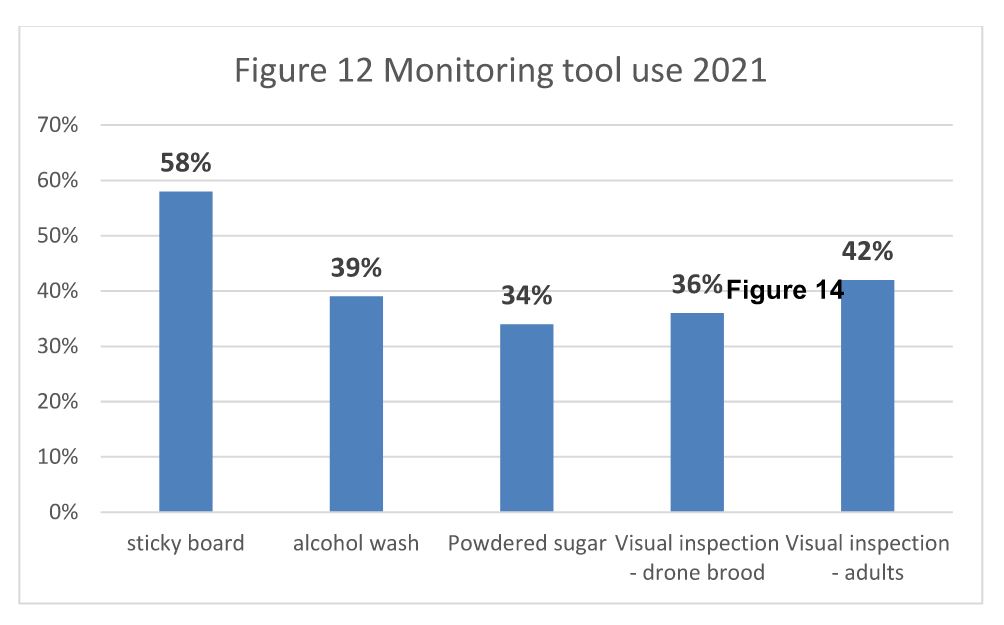
Most sampling to monitor mites was done in July – September, as might be expected since mite numbers change most quickly during these months and results of sampling can most readily be used for control decisions. See Figure 13 below for number of months each of the 5 sampling methods were used.
The most common sampling of respondents in 2020-21 was sampling both pre and post (both 33%) followed by treated but did not sample (26% of individuals). Pre-monitoring was more frequent compared to a post treatment monitoring. For this question only 18% checked not sampling whereas 20% had previously indicated not monitoring. Figure 14 right.
It is important to KNOW mite numbers. Less effective mite monitoring methods include sticky (detritus) boards below the colony (often so much detritus drops onto a sticky board that picking out the mites can be hard, especially for new beekeepers) but sticky boards used for a day can help confirm the useful of a treatment when inserted post treatment. Visual sampling is not accurate: most mites are not on the adult bees, but in the brood. Unfortunately looking for mites on drone brood is also not effective as a predictive number but can be used as an early warning that mites are present; if done, look at what percentage of drone cells had mites.
See Tools for Varroa Monitoring Guide www.honeybeehealthcoalition.org/varroa on the Honey Bee Health Coalition website for a description of and to view videos demonstrating how best to do sugar shake or alcohol wash sampling. The Tools guide also includes suggested mite level to use to base control decisions based on the adult bee sampling. A colony is holding its own against mites if the mite sample is below 2%. It is critical to not allow mite levels to exceed 2% during the fall months when bees are rearing the fat fall bees that will overwinter. It is also the most difficult time to select a control method (if one is deemed needed) as potential treatment harm may negatively impact the colony. We are seeing more colonies suddenly disappear (abscond?) during the fall, which may be related to the treatment itself.
Mite Control Treatments
The survey asked about non-chemical mite treatments and also about use of chemicals for mite control. Eighteen individuals (11%), 5 individuals less than last year, said they did not employ a non-chemical mite control and 35 individuals (21%), same number as last year but four and a half percentage points fewer than last year, did not use a chemical control. See Figure 14. Those 18 individuals who did not use a non-chemical treatment reported a 39% winter loss, while those who did not use a chemical control lost 65% of their colonies. The individual options chosen for non-chemical and chemical control are discussed below.
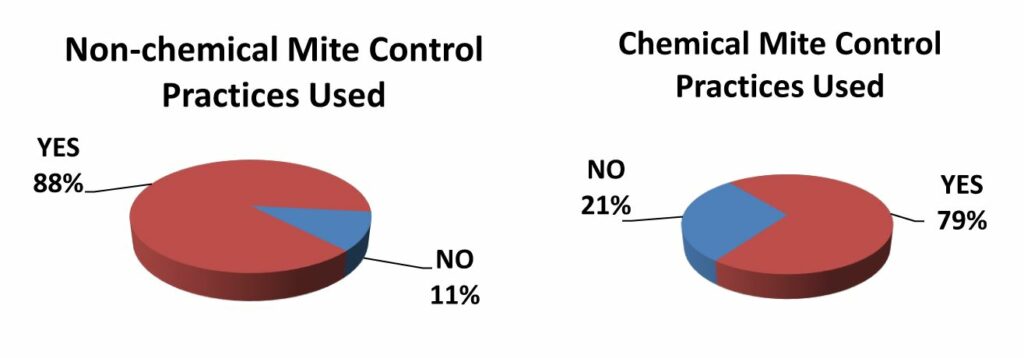
Non-Chemical Mite Control: Of nine non-chemical alternatives offered on the survey (+ other category,) 327 selections were indicated 2.3/person (last year 2/individual). Thirty-eight individuals used one method and had a 35% loss, 44 used two (28% loss level), 32 used three (38% loss), 11 used four and had 53% loss and 4 used 5 to 7 with a 31% loss. Use of screened bottom board was listed by 103 individuals (71% of individuals). They had average losses. The next most common selection was minimal hive inspection (55 individuals) and they had 6 percentage point higher losses. The use of the remaining 7 selections are shown in Figure 15; number of individuals in ( ), bar length represents average loss level of those individuals using each method. Those to left of green dashed line had better than average survival.
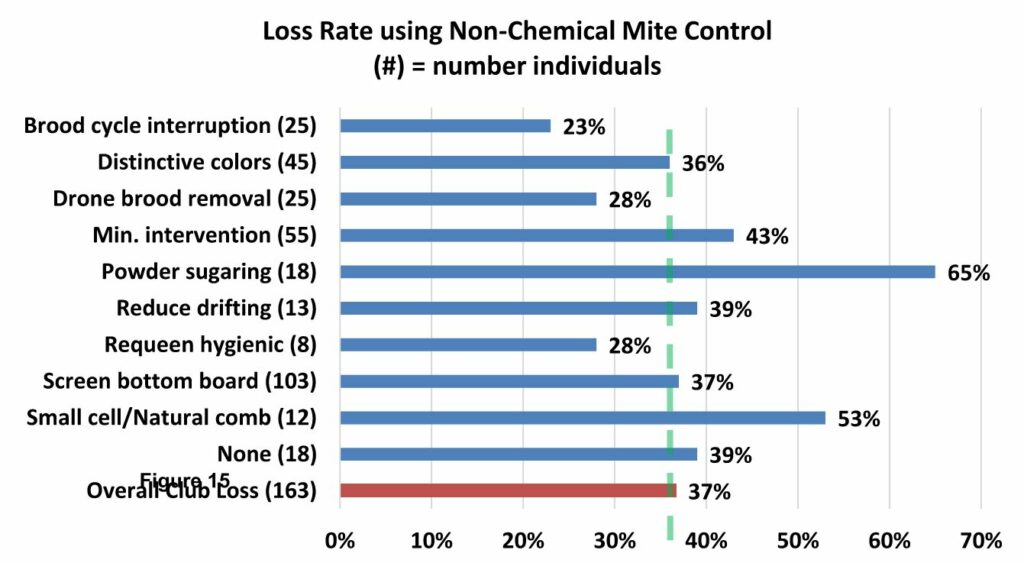
Three of the non-chemical alternatives demonstrated reduced losses this past year – requeening with hygienic queens has not been showing better survival in previous years while drone brood removal (25 individuals) and brood cycle interruptions (also 25 individuals) have also been useful in previous year surveys in reducing winter losses (in some of past 5 years but not all). Painting hives distinctive colors has resulted in better survival in each of past three survey years: this year by only single percentage point. Small cell/natural comb and powder sugaring has not been demonstrating better survival this year or in past years.
Chemical Control: For mite chemical control, 35 individuals (21 ½ % of total respondents) used NO chemical treatment; these individuals had a 63% loss level (same as last year). Those using chemicals used at rate of 1.7/individual. Fifty-eight individuals (45%) used one chemical and had 53% loss, (38 used Oxalic Acid vaporization had 27% loss, the 2 MAQS users had 25% loss, all other single chemical users had heavier than average loses), 52 used two and had 30% loss, 13 used 3 (32% loss) and the 4 using 4 to 6 had 48% loss. Figure 16 illustrates number of uses ( ) and bar length indicates the loss rate for those using that chemical.
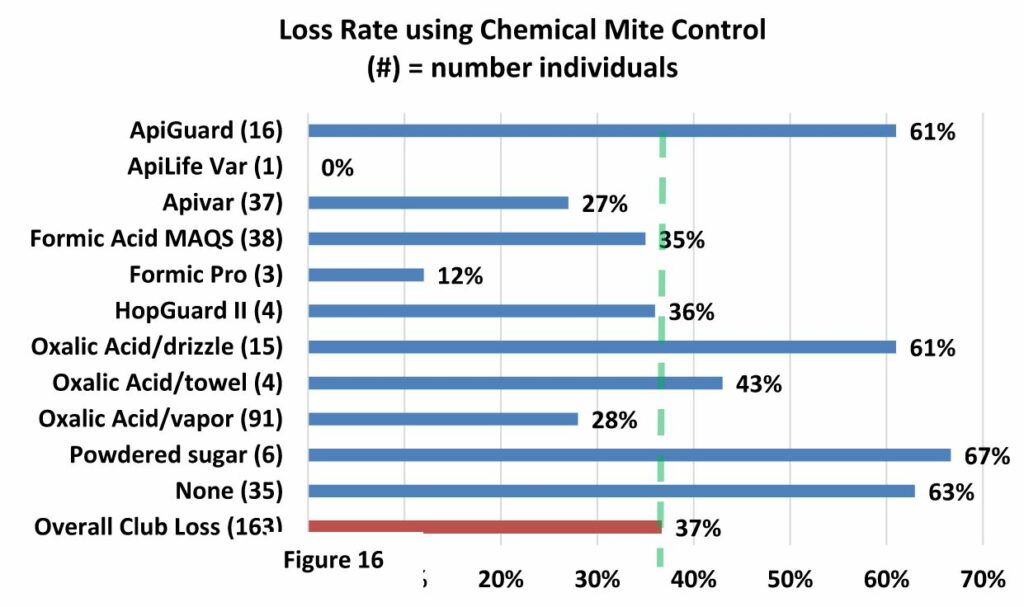
Consistently the last 3-4 years five different chemicals have helped beekeepers realize better survival. The essential oils Apiguard and ApiLifeVar have consistently demonstrated the lowest loss level; this year Apiguard did not perform as well for the 16 users, but Apiguard has a 37% better survival over last 5 years and ApiLifeVar has a 30% better survival record over past 4 years; no Washington respondents indicated use this year Apivar use, the synthetic (amitraz), has demonstrated a 29% better survival over past 5 years (2017-21). Oxalic acid vaporization over past 4 years has a 18% better survival (the survey did not differentiate Oxalic vaporization from drizzle prior before 2018). Formic acid demonstrated a 14% better survival, but this product has changed and how we use it is changing so this information is more difficult to tease out of the data. This past season Formic Pro performed better for 3 who used it than the traditional formic MAQs pads while the homemade remedy using formic acid did not for the four users.
The monthly use of Apivar (blue line), essential oil (red line) or an acid (green line) is shown in Figure 17. Further review is needed to determine if the timing of treatments was more effective than at other times for the various chemicals.
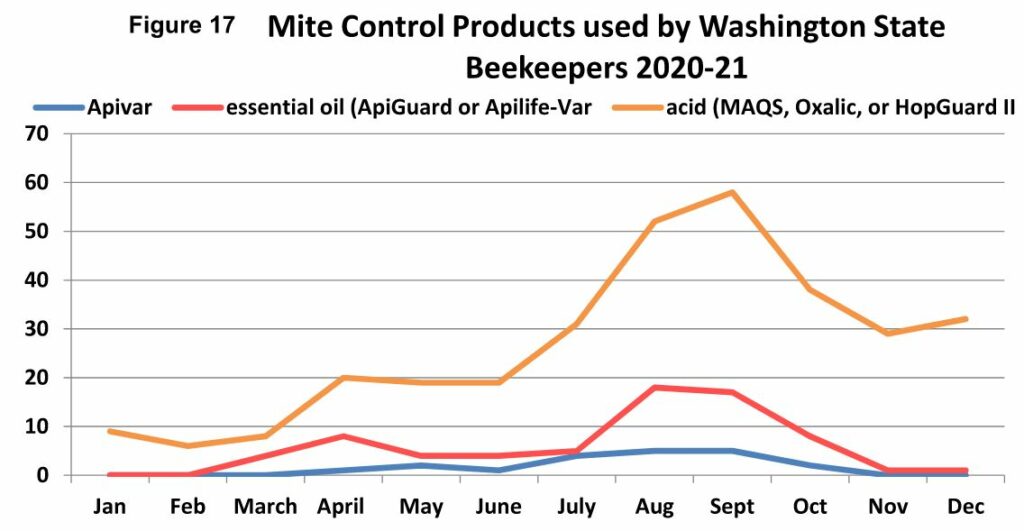
Antibiotic use
Two individuals used Fumigilian (for Nosema control); their loss rate was 42%, slightly higher than overall loss level. One used nosevet in addition (29% loss, slightly less than average). And the same individual (with 7 colonies indicated use of terramycin (29% loss).
Queens
We hear lots of issues related to queen “problems.” In Section 8 of the survey, we asked what percentage of loss could be attributed to queen problems. Forty six individuals (30%) subdivided queen related issues from 10 to 100% of their hives; the majority (25 individuals) indicated 10 to 30%. Forty-two individuals said none; an additional 36 individuals said they didn’t know. The number of respondents and percent losses of each is shown in Figure 18.
Queen events can be a significant factor contributing to a colony not performing as expected. We asked if you had marked queens in your hives. Forty-one percent% said yes. The related
question then was ‘were your hives requeened in any form?’ to which 56% (91 individuals) said yes, 24% said no. and the remainder ‘not that that I am aware of.’
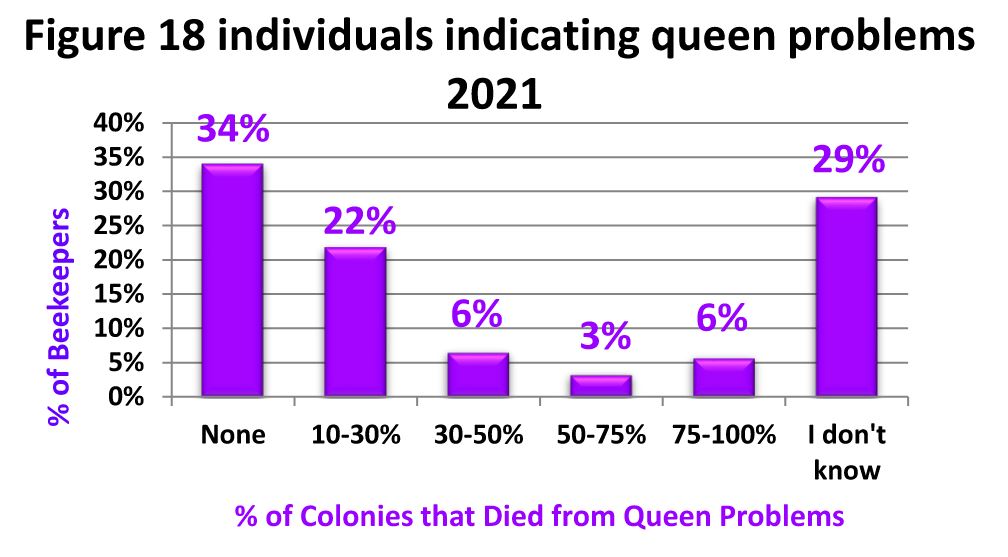
One technique to reduce mite buildup in a colony is to requeen/break the brood cycle. The question “How did bees/you requeen“ received 140 responses (more than one option could be checked). as illustrated in last figure. Forty-two individuals indicated they requeened with a mated queen and they had a 25% loss level, two used a virgin queen (42% loss) and 8 used a queen cell (12% loss). A higher percentage said the bees requeened via Supersedure (23 individuals, 39% loss), splitting (38 individuals, 30% loss) or swarming (37 individuals, 37% loss). With the exception of use of mated queen and splitting, loss levels were very similar.
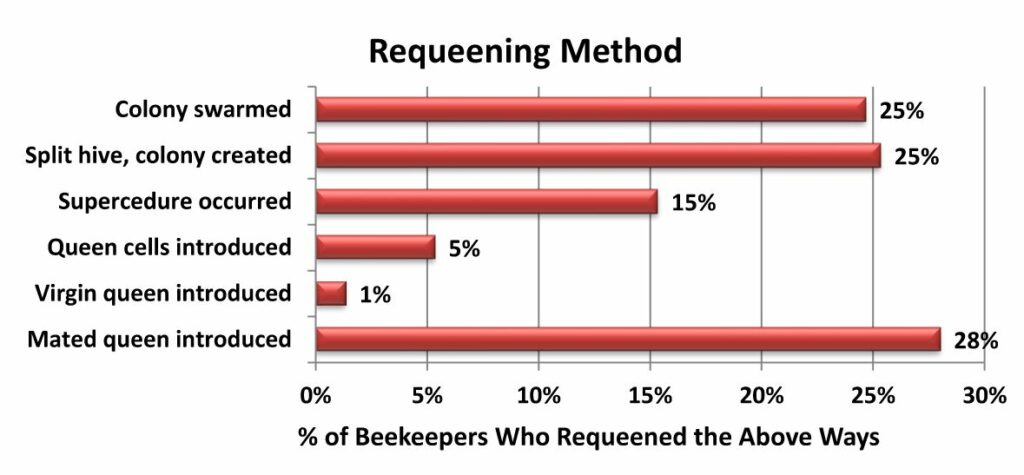
Closing comments
This survey is designed to ‘ground truth’ the larger, national Bee Informed loss survey. Some similar information is additionally available on the BeeInformed website www.beeinformed.org and individuals are encouraged to examine that data base as well. Recall that the BeeInformed survey is reporting losses of the larger scale WA beekeepers not the backyarders (Figure 5). Reports for individual bee groups with 18 or more respondents are customized and posted to the PNW website.
We intend to continue to refine this instrument each season and hope you will join in response next April. If you would like a reminder when survey is open please email us at [email protected] with “REMINDER” in the subject line. We have a blog on the pnwhoneybeesurvey.com and will respond to any questions or concerns you might have.
Thank You to all who participated. If you find any of this information of value, please consider adding your voice to the survey in a subsequent season.
